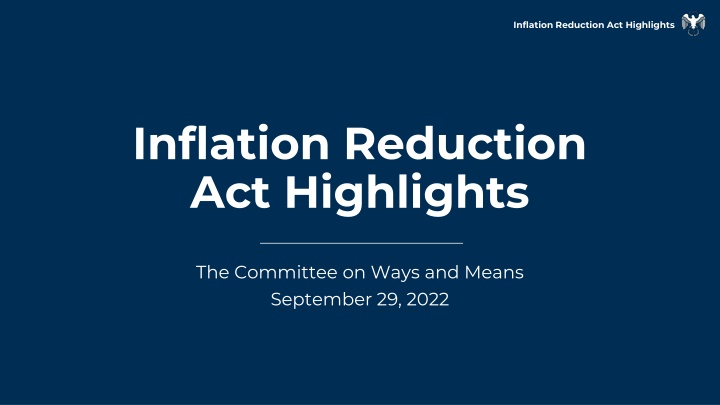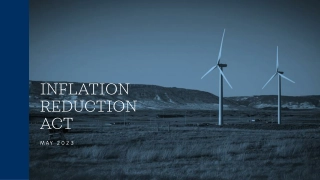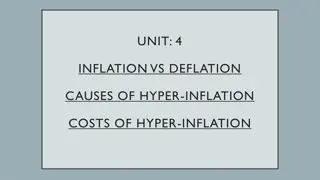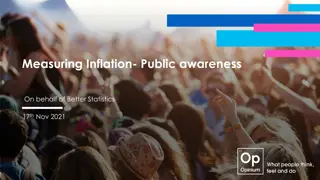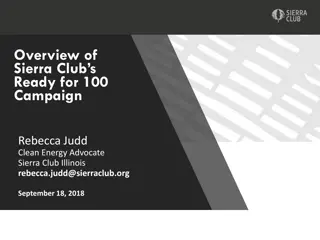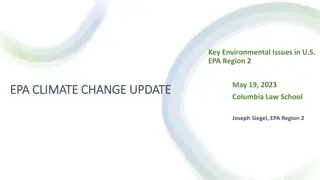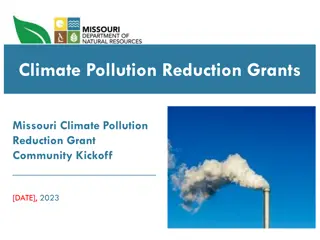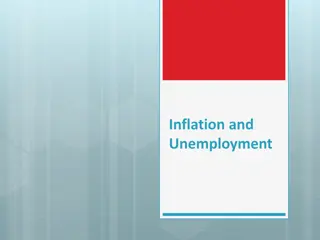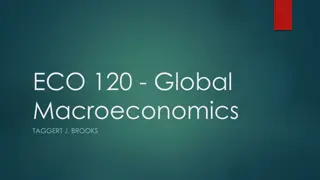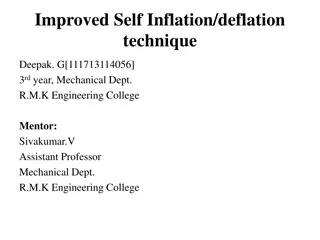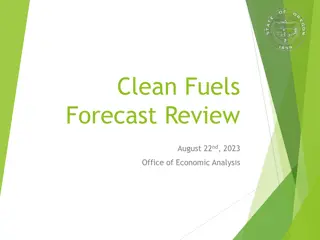Inflation Reduction Act Highlights: Climate Action & Clean Energy Investment
This highlights the Inflation Reduction Act's focus on climate action, clean energy investment, and its potential impact on emissions reduction, job creation, public health benefits, and infrastructure development for a clean energy economy. The bill emphasizes reducing greenhouse gas emissions, investing in clean energy, energy efficiency, and clean manufacturing, and fostering a transition to a sustainable, low-carbon future.
Download Presentation

Please find below an Image/Link to download the presentation.
The content on the website is provided AS IS for your information and personal use only. It may not be sold, licensed, or shared on other websites without obtaining consent from the author.If you encounter any issues during the download, it is possible that the publisher has removed the file from their server.
You are allowed to download the files provided on this website for personal or commercial use, subject to the condition that they are used lawfully. All files are the property of their respective owners.
The content on the website is provided AS IS for your information and personal use only. It may not be sold, licensed, or shared on other websites without obtaining consent from the author.
E N D
Presentation Transcript
Inflation Reduction Act Highlights Inflation Reduction Act Highlights The Committee on Ways and Means September 29, 2022
Inflation Reduction Act Highlights Climate Tax (GREEN Act)
Inflation Reduction Act Highlights Climate Overview To prevent the worst effects of climate change, we must reduce our greenhouse gas emissions by 50 percent by 2030. This bill is the largest federal investment in climate in U.S. history. It will reduce emissions by 40 percent by 2030, putting our nation within reach to meeting President Biden s commitment of 50-52 percent. This bill will: save the averageAmerican household hundreds in energy bills and other costs, spur 9 million jobs by investing in clean energy, energy efficiency, and clean manufacturing generate enormous public health benefits by preventing up to 3,900 premature deaths and 100,000 asthma attacks annually from air pollution. The bill sets up the infrastructure for our 21st century clean energy economy. One that rests on good-paying, union jobs and American workers
Inflation Reduction Act Highlights Ways and Means Contributions The GREEN Act First released as a discussion draft in 2019 by all Ways and Means Democrats, building on decades of energy tax policy Passed by the House in 2020 as part of H.R.2 (the Moving Forward Act) Marked up and passed as part of the Build Back Better Act in 2021 Formed the foundation of the Inflation Reduction Act What got done 70% of the climate investments ($270B of $370B) Most of the emissions reductions Provisions spanning almost every area touched by the bill: electricity generation, energy efficiency, clean fuels, electric vehicles, labor and domestic manufacturing, environmental justice
Inflation Reduction Act Highlights Clean Electricity Generation: Background This bill provides 10+ years for renewable technologies like solar, wind, geothermal, and hydropower with a restoration to the full value of the investment tax credit and the production tax credit for these technologies New tax credits for batteries and other energy storage technologies to enable renewable technologies and make our grids more resilient to extreme weather events and blackouts Bonus credits are available for domestic content and projects in energy communities (including brownfields) There is also an environmental justice bonus credit your constituents can apply to for solar and wind targeted to 1) projects in low-income census tracts (including low- and moderate-income individuals leasing solar panels on their roofs), 2) on affordable housing, and 3) low- and moderate-income community solar Nonprofits (like public power, rural coops, and nonprofit hospitals) and state and local governments can take advantage these tax credits for the first time through direct pay (through a Treasury application) Enhanced carbon capture credits incentivize gas power plants to reduce their emissions
Inflation Reduction Act Highlights Clean Electricity Generation: Messaging This bill devotes billions of dollars to jump-starting our investments in proven and new clean energy projects. The 10+ years of benefits provide these projects with the certainty they need to make long-term investments. These investments will lower energy costs for individuals by adding renewable energy to the grid and boosting our domestic energy independence. Green jobs are good jobs: To receive these credits, the developers need to pay prevailing wages and support apprenticeships.
Inflation Reduction Act Highlights Clean Fuels: Background The bill extends credits to promote low-carbon fuels such as biodiesel The bill tackles one of the hardest-to-decarbonize sectors, aviation, through a new credit for sustainable aviation fuel The bill incentivizes new low-carbon fuel pathways: Creates a new tax credit for hydrogen production that scales up based on reduction in carbon emissions, with zero-carbon hydrogen qualifying for the largest credit. New "tech-neutral" credit allows other low-carbon fuel pathways to qualify
Inflation Reduction Act Highlights Clean Fuels: Messaging Promoting alternate fuels is crucial to reducing our reliance on petroleum and meeting our carbon reduction goals. Sustainable Aviation Fuel is a new and innovative tool to reduce the carbon footprint of air travel, one of the biggest contributors to global carbon emissions. By promoting new zero carbon fuels, like green hydrogen, this bill jumpstarts innovative technologies that will propel us into the future, including decarbonizing our industrial sector.
Inflation Reduction Act Highlights Energy Efficiency and Clean Energy Incentives for Individuals and Businesses: Background Provides 10 years of expanded tax credits to help individuals and business owners invest in energy efficiency, including Helping homeowners afford electric and energy-efficient home upgrades, including 1) HVAC and water heaters, 2) building envelope (including insulation), 3) doors and windows, 4) electric panel upgrades Incentivizing building new single- and multi-family energy efficient homes (45L credit) Incentivizing energy efficient commercial buildings (179D deduction), now more accessible to nonprofits and to older buildings looking to perform retrofits Provides 10 years of tax credits for individuals and businesses for rooftop solar, as well as other renewable technologies. Individuals and businesses can also install batteries in their homes for energy storage to protect against blackouts and to pair with renewables.
Inflation Reduction Act Highlights Energy Efficiency and Clean Energy Incentives for Individuals and Businesses: Messaging Helps families save on energy bills by lowering the cost of rooftop solar and energy efficient appliances and weatherization by as much as 30 percent This makes transition to solar affordable for everyone Even if you lease (as opposed to own) solar panels, or subscribe to community solar, these tax benefits will ultimately flow-through to customers, especially individuals in low-income areas Encourages businesses to go green. Businesses and nonprofits looking to build additional space or retrofit an existing building can offset more of their costs
Inflation Reduction Act Highlights Clean Vehicles: Background 10 years of tax credits for electric, fuel-cell, and plug-in hybrid vehicles up to $7,500 for buying a new EV. Limited to taxpayers making $300,000 (married)/ $150,000 (single) based on prior- or current- year modified AGI Limited to vehicles with a MSRP up to $55,000 ($80,000 in the case of vans, pickup trucks and SUVs). For participating dealers, buyers (e.g. low-income buyers) can transfer credit to the dealer, which claims the credit and lowers the purchase price at point-of-sale Applies only to vehicles that: Are assembled in North America (already in effect) Meet certain geographic restrictions on critical mineral and battery components (starts 2023, and ramps up through 2027) Cannot have any battery components or critical minerals from a "foreign entity of concern" (starts in 2024/2025 respectively)
Inflation Reduction Act Highlights Clean Vehicles: Background (II) New credit to make used vehicles more affordable for low- and moderate-income individuals by providing up to $4,000 for buying a used EV Limited to taxpayers making $150,000 (married)/ $75,000 (single) (based on prior-year or current year modified AGI) Transfer available to participating dealers New credit for commercial EVs, which will apply purchases ranging from light- duty vehicles for mom-and-pop businesses; to delivery vans, busses, and trash trucks; to farm and construction equipment. Nonprofits and state and local governments can take advantage of the credit as well via a "direct pay" mechanism. Extends the credit for purchasing and installing home EV charging equipment and extends and expands the credits for constructing EV charging stations.
Inflation Reduction Act Highlights Clean Vehicles: Messaging These are sensible provisions that will accelerate the electrification of our vehicles; this is a bridge to the future of automobiles. This is not about helping the rich. The income limitations and used vehicle credit ensure that middle-income families can afford electric vehicles. This is not about luxury cars. This promotes U.S. manufacturing jobs. All eligible cars are assembled in North America. The battery component and critical mineral sourcing content is crucial to ensuring that our domestic supply chain won't be interrupted, and that we will not be dependent upon China to produce these automobiles.
Inflation Reduction Act Highlights Clean Vehicles: Messaging For businesses, the commercial EV credit represents a valuable opportunity. There are fewer limitations on the commercial EV credit, making the market ripe for rapid growth If you have constituent businesses that use cars, delivery vans, or trucks, encourage them to consider how this credit can bring down the cost of an electric vehicle in 2023. They can save up to $7,500 on a new light-duty vehicle, and up to $40,000 on a medium- or heavy-duty vehicle. Municipalities could save up to $40,000 on vehicles like busses or trash trucks through the direct pay option. Farm businesses may receive a credit of up to $40,000 on tractors and other heavy farm equipment.
Inflation Reduction Act Highlights Clean Vehicles: Frequently Heard Criticisms "I've heard that no vehicles are going to be able to qualify and no one will be able to get a tax credit." Automakers are evaluating their supply chains in light of these new provisions, which are intended to incentivize domestic supply chains. That is why the IRA also includes strong domestic manufacturing provisions, including dedicated credits for the production of battery components and critical minerals. Treasury will have to provide guidance on how to implement the new requirements. Additionally, the new content requirements do not apply to the new used EV credit and commercial EV credit. The commercial EV credit applies to light-duty vehicles as long as the property is for a business use. "What if I already purchased a vehicle?" IRS has provided guidance that if one had a written, binding agreement to purchase a vehicle before August 16, 2022, the new North America assembly requirement does not apply even if the vehicle is delivered after.
Inflation Reduction Act Highlights Clean Jobs and Manufacturing: Background Groundbreaking labor and domestic content standards will ensure new, good-paying jobs. Many energy and energy efficiency projects will need to meet prevailing wage and apprenticeship requirements Domestic content bonus available for technologies like solar/wind Revival of the 48C advanced manufacturing credit ($10B), which your constituents can apply to for an allocation for the 1) production of a wide range of manufacturing and industrial facilities relating to clean advanced manufacturing, and 2) modifications to manufacturing and industrial facilities to reduce emissions New manufacturing PTCs provide a credit per unit produced for solar, wind, battery components, and critical minerals Enhanced carbon capture credits help industrial facilities reduce their emissions
Inflation Reduction Act Highlights Clean Manufacturing: Messaging The Blue-Green Alliance estimates that the IRA will create 9 million good-paying jobs over the next decade.
Inflation Reduction Act Highlights Revenue Raisers
Inflation Reduction Act Highlights IRS Funding: Background Makes around $80 billion worth of critical investments in the IRS to improve taxpayer services and ensure that well-heeled taxpayers with armies of lawyers can no longer shirk their tax obligations with impunity, including: $3.18 billion for taxpayer services (4.01%) $45.6 billion for enforcement (57.5%) $25.3 billion for operations support (31.9%) $4.75 billion for business systems modernization (5.98%) $500 million to implement clean energy provisions (0.63%) Investments in Treasury to oversee implementation of IRA $403 million to Treasury Inspector General $104.5 million to Office of Tax Policy $50 million to departmental offices $15 million to study the feasibility of a free e-filing system $153 million to Tax Court to adjudicate tax disputes
Inflation Reduction Act Highlights IRS Funding: Messaging The bill revitalizes the IRS to meet the challenges of today and the benefits are numerous: The funding will allow the IRS to better serve taxpayers, cutting down the backlog and wait times The IRS will have the tools it needs to go after wealthy tax cheats The funding will generate billions of dollars of revenue for the Federal government all from collecting taxes that are already owed. The IRS and Treasury have announced that they will put systems in place to make sure audits will not increase for those making less than $400,000 Treasury has announced an initial plan to use the funding immediately for customer service upgrades including fully staffing Tax Assistance Centers and hiring more customer service representatives to cut phone wait times.
Inflation Reduction Act Highlights IRS Funding: Frequently Heard Criticism "Are 87,000 new armed agents going to come knocking on my door?" The 87,000 number refers to the number of IRS staff (including technology and customer service staff) that is estimated to be hired over 10 years Much of the new staff will be replacing the IRS s aging workforce, many of which are at or nearing retirement (around 63%) A very tiny portion (around 3%) of the IRS workforce is armed. And they are armed for a reason. They work for the IRS Criminal Investigation department. They are tasked with rooting out financial crimes from Russian oligarchs attempting to evade sanctions to other illicit attempts to defraud the US government. Think tracking down the illegally gotten gains of Al Capone, Pablo Escobar, and Saddam Hussein.
Inflation Reduction Act Highlights Corporate Alternative Minimum Tax: Background Imposes a new, 15% corporate alternative minimum tax on the applicable financial statement income of corporations with at least $1 billion in pre-tax income. A corporation is liable for the CAMT to the extent its minimum tax liability exceeds its regular federal income tax liability (computed without business credits). Applicable financial statement income (the base of the CAMT) is subject to adjustments, including for reductions for tax depreciation, reductions for financial statement net operating losses, removal of income/expenses related to defined benefit plans, and the removal of income received from the "direct pay" green energy provisions. Note: The CAMT is not the 15% global minimum tax the House passed in 2021 by amending GILTI. Rather, it is a Senate compromise provision to replace an increase in the regular federal corporate income tax rate, which did not have 50 votes in the Senate. In general, corporations potentially subject to the CAMT will want to minimize their applicable financial statement income. Since Treasury is given a wide regulatory grant to elaborate on financial statement income adjustments, you will likely hear from taxpayers on advocating with Treasury about reductions to/exclusions from financial statement income.
Inflation Reduction Act Highlights Corporate Alternative Minimum Tax: Messaging The corporate alternative minimum tax in the Inflation Reduction Act ensures that the largest corporations pay their fair share. Only corporations that earn more than $1 billion in income and do not pay at least a 15% tax rate are eligible. According to JCT, up to 125 corporations that average nearly $9 billion in income paid tax rates of just 1.1%. The CAMT addresses this inequity and uses the over $200 billion raised to invest in critical priorities like lowering drug prices and combatting climate change.
Inflation Reduction Act Highlights Excise Tax on Stock Buybacks: Background Over the past 25 years, stock buybacks have exploded: Companies now borrow money or use extra cash to buy back stock rather than paying dividends or investing in workers Imposes a 1% tax on the amount of the net amount of stock buybacks by public corporations in the corporation s taxable year The tax does not apply to buybacks that are already taxed as dividends or part of a tax- free merger, or to stock that s contributed to an ESOP or an employer-sponsored retirement plan The tax also does not apply if stock buybacks do not exceed $ 1 M in a year or to stock buybacks by REITs and RICs
Inflation Reduction Act Highlights Excise Tax on Stock Buybacks: Messaging This modest tax: Encourages companies to invest in workers and their businesses rather than in financial games Reduces the tax advantage from stock buybacks and encourages companies to pay dividends instead Foreign investors in US stock generally are taxed on dividends but are not taxed on stock buybacks Only impacts public corporations, not small businesses Ensures large corporations and their wealthy investors pay their fair share
Inflation Reduction Act Highlights Inflation Reduction Act and Health The Inflation Reduction Act the greatest health care achievement since the passage of the Affordable Care Act
Inflation Reduction Act Highlights Health Care: The Inflation Reduction Act By the Numbers 13 million Americans will save on their health insurance premiums starting in 2023, saving an average of $2,400 per family. 49 million Medicare beneficiaries will no longer face Big Pharma s outrageous price hikes that outpace inflation beginning in 2023. $35 insulin copays for Medicare beneficiaries beginning in 2023. 49 million Medicare Part D beneficiaries will have out-of-pocket costs for prescription drugs capped at $2,000 per year beginning in 2025. 80 of the most expensive prescription drugs will have lower prices because of Medicare negotiations by 2030. Free vaccines for all Medicare beneficiaries under Part D.
Inflation Reduction Act Highlights Affordable Care Act (ACA) Provisions: Background Under the American Rescue Plan (ARP), Congressional Democrats strengthened the ACA by enhancing the Premium Tax Credits (through 2022), making health coverage more affordable for low and middle-income families. The ARP ensured that no American would pay more than 8.5% of their income on health care premiums. And Americans earning less than 150 percent of the Federal Poverty Level (who were not eligible for Medicaid) could enroll in zero- dollar premium plans. The IRA extended these enhanced ACA premium tax credits for an additional 3 years - through 2025.
Inflation Reduction Act Highlights IRA ACA: Messaging With the Inflation Reduction Act, Democrats secured the most significant investment in more accessible, affordable, and equitable health coverage since ACA. IRA locks in lower premiums for 13 million people, saving the average American $800 per year, and the average family $2,400. Now, 14.5 million people, who gained marketplace coverage this year, won't face premium spikes that could've doubled or tripled their costs. Capping premium costs at 8.5% of income protects affordability for middle income families who previously faced a subsidy cliff. More than a quarter of all Marketplace enrollees have premiums of under $10 a month.
Inflation Reduction Act Highlights Drug Pricing: Background Medicare Negotiation: for the first time, Medicare won t have to accept the prices dictated by drug companies. The Inflation Reduction Act requires Medicare to negotiate the prices of certain high-cost drugs finally undoing the nearly 20-year ban on Medicare negotiating better prices on behalf of beneficiaries. Curbing unfettered drug company price hikes: penalties for drug price increases that outpace inflation in Medicare, beginning in 2022. Limits on out of pocket costs: beginning in 2024, Medicare Part D beneficiaries will have no out-of-pocket costs once they reach the catastrophic threshold. In 2025, there will be a $2,000 cap on what enrollees pay out-of- pocket annually. Currently there s no limit to what Medicare Part D enrollees can pay annually for their prescription drugs for some this can lead to more than $15,000 in out-of-pocket spending annually. Lower prices for insulin: $35 cap on insulin will amount to savings of several hundred dollars per year for the average beneficiary taking insulin. Zero cost vaccines: the IRA provides free access to critical vaccines like the shingles vaccine which currently costs most seniors $100.
Inflation Reduction Act Highlights Drug Pricing Provisions: Messaging The Inflation Reduction Act is the most significant victory over Big Pharma in decades. Democrats tried for nearly 20 years to give Medicare the authority to negotiate lower drug prices. Americans spend more than any other industrialized nation on prescription drugs, and with this legislation, Medicare will finally negotiate prices for certain high-cost drugs, cap the cost of insulin at $35 per month, and cap out-of-pocket costs for seniors at just $5 per day. President Biden and Congressional Democrats took on unified Republican opposition and Big Pharma s millions of dollars in lobbying, political contributions, and misleading paid advertising. Big Pharma one of the country s most influential and powerful entrenched interests spent over $100 million lobbying this year alone to kill any proposal to rein in high drug costs that threaten their massive profits made on the backs of American consumers. IRA is a momentous achievement for anyone concerned with the high cost of health care in this country.
Inflation Reduction Act Highlights Democrats Deliver Health Care Cost Savings The Inflation Reduction Act will save millions of Americans thousands of dollars a year by lowering the cost of their prescription drugs and health coverage. Democrats' efforts ensure a record number of Americans have good insurance coverage and contained Medicare premium increases. Fewer Americans are without health insurance than ever before. 5.2 million Americans gained health coverage since 2020--a direct result of Democrats' ACA policies. For the first time in more than a decade, premiums for Medicare Part B will decrease next year - by over $60 per beneficiary per year.
